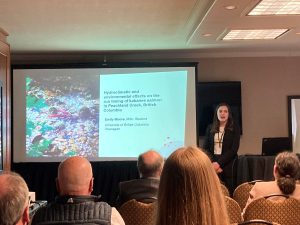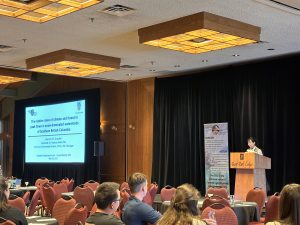This past May, a team of three Watershed Ecosystems Project researchers including Dr. Sheena Spencer and graduate students Jinyu Hui and Emily Moore, attended the 2023 Annual Meeting of the Canadian Geophysical Union in Banff, Alberta, where both Hui and Moore presented their research relating to Peachland Creek and the Watershed Ecosystems Project.
The Canadian Geophysical Union, with over 400 members and five distinct Sections (Hydrology, Geodesy, Solid Earth, Biogeosciences, and Earth Surface Processes) functions as a national organization for geophysical scientists, offering annual meetings, award programs, exposure to funding opportunities, and advocacy in policymaking. (Canadian Geophysical Union. 2023. https://cgu-ugc.ca/ Accessed June 2, 2023.)
The theme for this year’s meeting was “Advancing Knowledge in Earth and Environmental Science”. Within the “Advances in Forest Hydrology” session, Hui’s presentation, entitled “The relative roles of climate and forest in peak flows in snow-dominated watersheds of British Columbia”, centered in a quantification of the contributions of climate variability and forest disturbance to changes in peak flows at the watershed scale. Hui outlined how her combined approach which includes paired watershed experiments determining the absolute impact of forest disturbance on peak flows, the employ of statistical and machine learning methods to establish the relationship between climate variability and peak flows, and the separation of their relative contributions, suggest that climate variability plays a more important role in extreme peak-flow events, and intensive forest disturbances have the ability to increase the magnitude and advancement of the timing of peak flows in snow-dominated watersheds.
Within the “CSAFM (Canadian Society of Agriculture and Forestry Meteorology)” session, Moore’s presentation, entitled “Hydroclimatic and environmental effects on the run timing of kokanee salmon in Peachland Creek, British Columbia”, provided a context of water scarcity and climate change in the Okanagan Valley, as well as the economic and cultural importance of kokanee to the region as driving factors for her research. Moore outlined the objective of her project as the identification of relationships between hydroclimatic factors (such as precipitation, air temperature, and stream flow) and the timing of the kokanee spawning period with the goal of better understanding the conditions required for an ideal spawning run and the prevention of detrimental advancement of the spawning period, which places salmon at risk of exposure to high water temperatures.
Dr. Spencer, Hui and Moore reflected upon many learnings from the conference experience, most prominent being a reminder of the immense value of sharing and discussion amongst researchers in collaborative settings, where contagious enthusiasm emerges as groups of innovative and dedicated people gather to connect, learn, and strategize around complex problems.

Emily Moore, MSc Student, Department of Earth, Environmental and Geographic Sciences, UBC Okanagan presenting at the Canadian Geophysical Union Annual Conference May, 2023.

Jinyu Hui, PhD Student, Department of Earth, Environmental and Geographic Sciences, UBC Okanagan presenting at the Canadian Geophysical Union Annual Conference, May 2023.
Article written by Rheanne Kroschinsky, with contributions from Jinyu Hui, Emily Moore and Sheena Spencer.